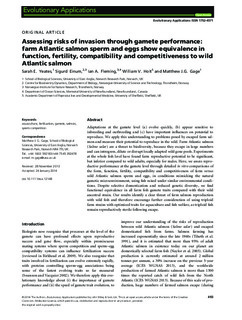| dc.contributor.author | Yeates, Sarah E. | |
| dc.contributor.author | Einum, Sigurd | |
| dc.contributor.author | Fleming, Ian A. | |
| dc.contributor.author | Holt, William V. | |
| dc.contributor.author | Gage, Matthew J.G. | |
| dc.date.accessioned | 2017-10-20T10:45:59Z | |
| dc.date.available | 2017-10-20T10:45:59Z | |
| dc.date.created | 2016-04-12T11:29:39Z | |
| dc.date.issued | 2014 | |
| dc.identifier.citation | Evolutionary Applications. 2014, 7 (4), 493-505. | nb_NO |
| dc.identifier.issn | 1752-4571 | |
| dc.identifier.uri | http://hdl.handle.net/11250/2461241 | |
| dc.description.abstract | Adaptations at the gamete level (a) evolve quickly, (b) appear sensitive to inbreeding and outbreeding and (c) have important influences on potential to reproduce. We apply this understanding to problems posed by escaped farm salmon and measure their potential to reproduce in the wild. Farm Atlantic salmon (Salmo salar) are a threat to biodiversity, because they escape in large numbers and can introgress, dilute or disrupt locally adapted wild gene pools. Experiments at the whole fish level have found farm reproductive potential to be significant, but inferior compared to wild adults, especially for males. Here, we assess reproductive performance at the gamete level through detailed in vitro comparisons of the form, function, fertility, compatibility and competitiveness of farm versus wild Atlantic salmon sperm and eggs, in conditions mimicking the natural gametic microenvironment, using fish raised under similar environmental conditions. Despite selective domestication and reduced genetic diversity, we find functional equivalence in all farm fish gamete traits compared with their wild ancestral strain. Our results identify a clear threat of farm salmon reproduction with wild fish and therefore encourage further consideration of using triploid farm strains with optimized traits for aquaculture and fish welfare, as triploid fish remain reproductively sterile following escape. | nb_NO |
| dc.language.iso | eng | nb_NO |
| dc.publisher | Wiley Open Access | nb_NO |
| dc.rights | Navngivelse 4.0 Internasjonal | * |
| dc.rights.uri | http://creativecommons.org/licenses/by/4.0/deed.no | * |
| dc.title | Assessing risks of invasion through gamete performance: Farm Atlantic salmon sperm and eggs show equivalence in function, fertility, compatibility and competitiveness to wild Atlantic salmon | nb_NO |
| dc.type | Journal article | nb_NO |
| dc.type | Peer reviewed | nb_NO |
| dc.description.version | publishedVersion | nb_NO |
| dc.source.pagenumber | 493-505 | nb_NO |
| dc.source.volume | 7 | nb_NO |
| dc.source.journal | Evolutionary Applications | nb_NO |
| dc.source.issue | 4 | nb_NO |
| dc.identifier.doi | 10.1111/eva.12148 | |
| dc.identifier.cristin | 1350055 | |
| dc.relation.project | Norges forskningsråd: 223257 | nb_NO |
| dc.description.localcode | © 2014 The Authors. Evolutionary Applications published by John Wiley & Sons Ltd. This is an open access article under the terms of the Creative Commons Attribution License (CC BY 3.0) (https://creativecommons.org/licenses/by/3.0/) | nb_NO |
| cristin.unitcode | 194,66,10,0 | |
| cristin.unitname | Institutt for biologi | |
| cristin.ispublished | true | |
| cristin.fulltext | original | |
| cristin.qualitycode | 1 | |

